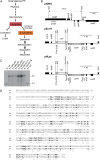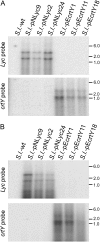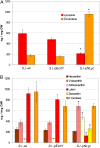Enhancement of carotenoid biosynthesis in transplastomic tomatoes by induced lycopene-to-provitamin A conversion
- PMID: 19587100
- PMCID: PMC2735999
- DOI: 10.1104/pp.109.140533
Enhancement of carotenoid biosynthesis in transplastomic tomatoes by induced lycopene-to-provitamin A conversion
Abstract
Carotenoids are essential pigments of the photosynthetic apparatus and an indispensable component of the human diet. In addition to being potent antioxidants, they also provide the vitamin A precursor beta-carotene. In tomato (Solanum lycopersicum) fruits, carotenoids accumulate in specialized plastids, the chromoplasts. How the carotenoid biosynthetic pathway is regulated and what limits total carotenoid accumulation in fruit chromoplasts is not well understood. Here, we have introduced the lycopene beta-cyclase genes from the eubacterium Erwinia herbicola and the higher plant daffodil (Narcissus pseudonarcissus) into the tomato plastid genome. While expression of the bacterial enzyme did not strongly alter carotenoid composition, expression of the plant enzyme efficiently converted lycopene, the major storage carotenoid of the tomato fruit, into provitamin A (beta-carotene). In green leaves of the transplastomic tomato plants, more lycopene was channeled into the beta-branch of carotenoid biosynthesis, resulting in increased accumulation of xanthophyll cycle pigments and correspondingly reduced accumulation of the alpha-branch xanthophyll lutein. In fruits, most of the lycopene was converted into beta-carotene with provitamin A levels reaching 1 mg per g dry weight. Unexpectedly, transplastomic tomatoes also showed a >50% increase in total carotenoid accumulation, indicating that lycopene beta-cyclase expression enhanced the flux through the pathway in chromoplasts. Our results provide new insights into the regulation of carotenoid biosynthesis and demonstrate the potential of plastids genome engineering for the nutritional enhancement of food crops.
Figures






References
-
- Al-Babili S, Hobeika E, Beyer P (1996) A cDNA encoding lycopene cyclase from Narcissus pseudonarcissus L. (PGR96-107). Plant Physiol 112 1398
-
- Armstrong GA (1997) Genetics of eubacterial carotenoid biosynthesis: a colorful tale. Annu Rev Microbiol 51 629–659 - PubMed
-
- Bock R (2001) Transgenic chloroplasts in basic research and plant biotechnology. J Mol Biol 312 425–438 - PubMed
-
- Bramley PM (2002) Regulation of carotenoid formation during tomato fruit ripening and development. J Exp Bot 53 2107–2113 - PubMed
Publication types
MeSH terms
Substances
LinkOut - more resources
Full Text Sources
Other Literature Sources

